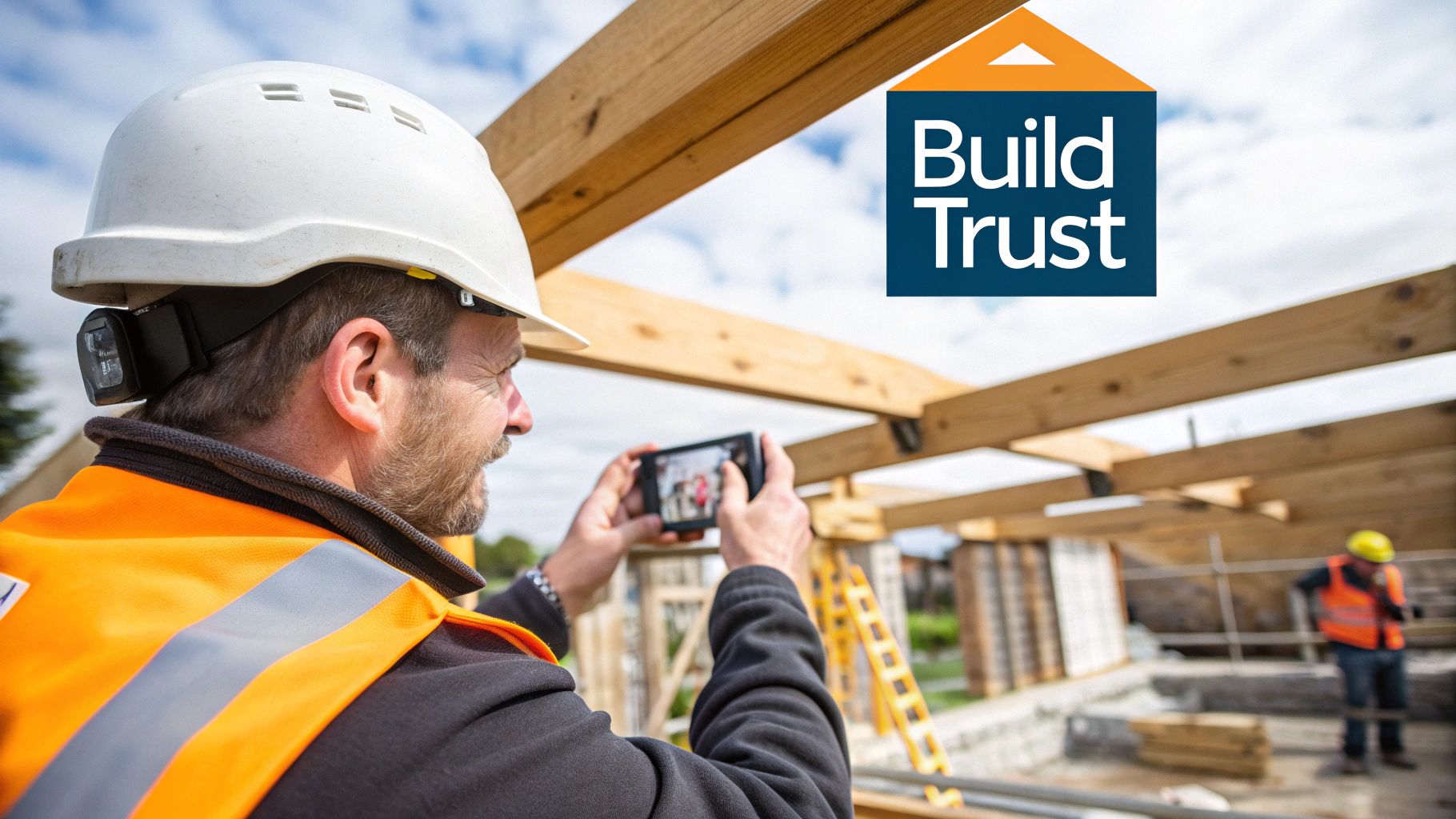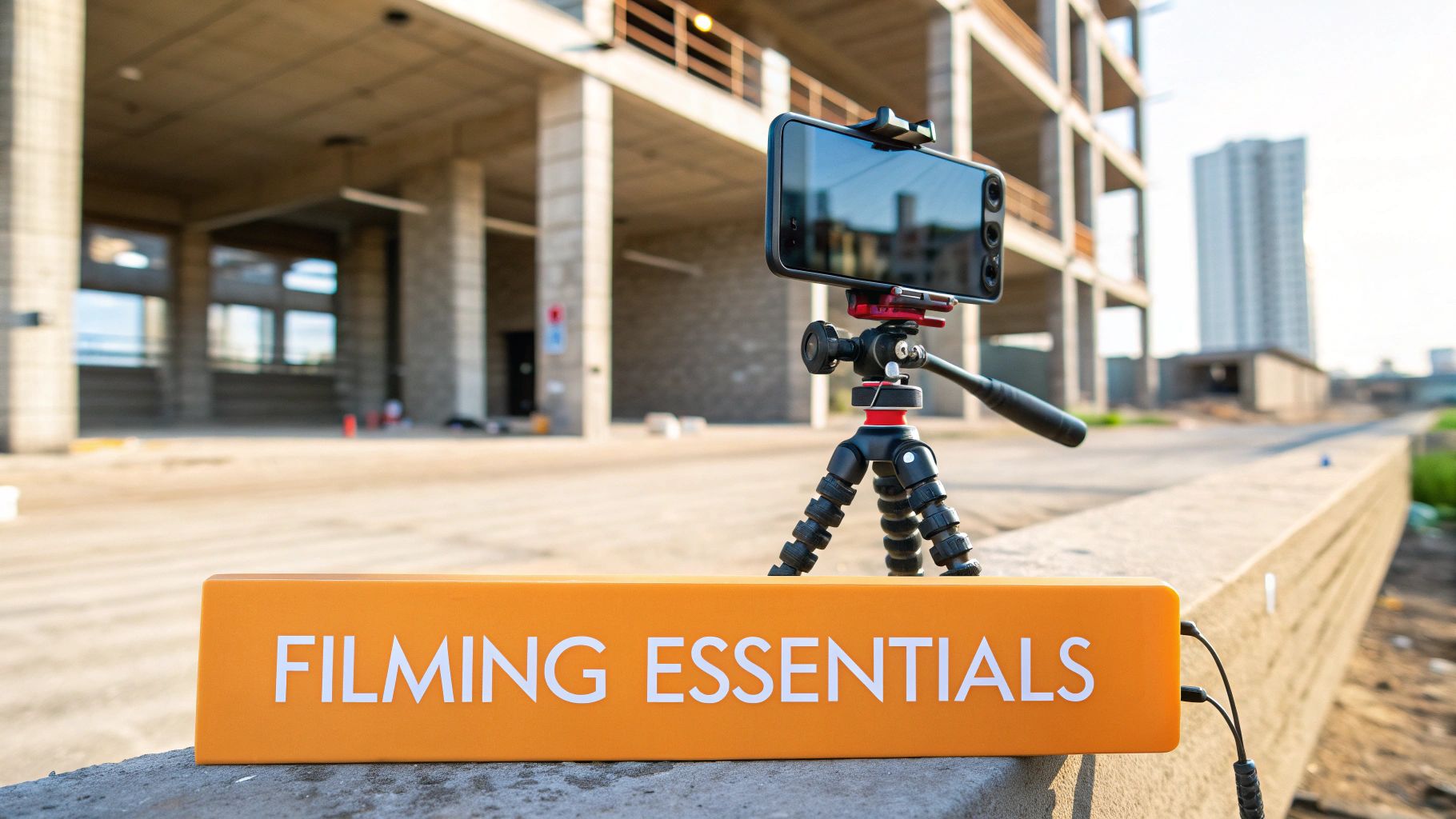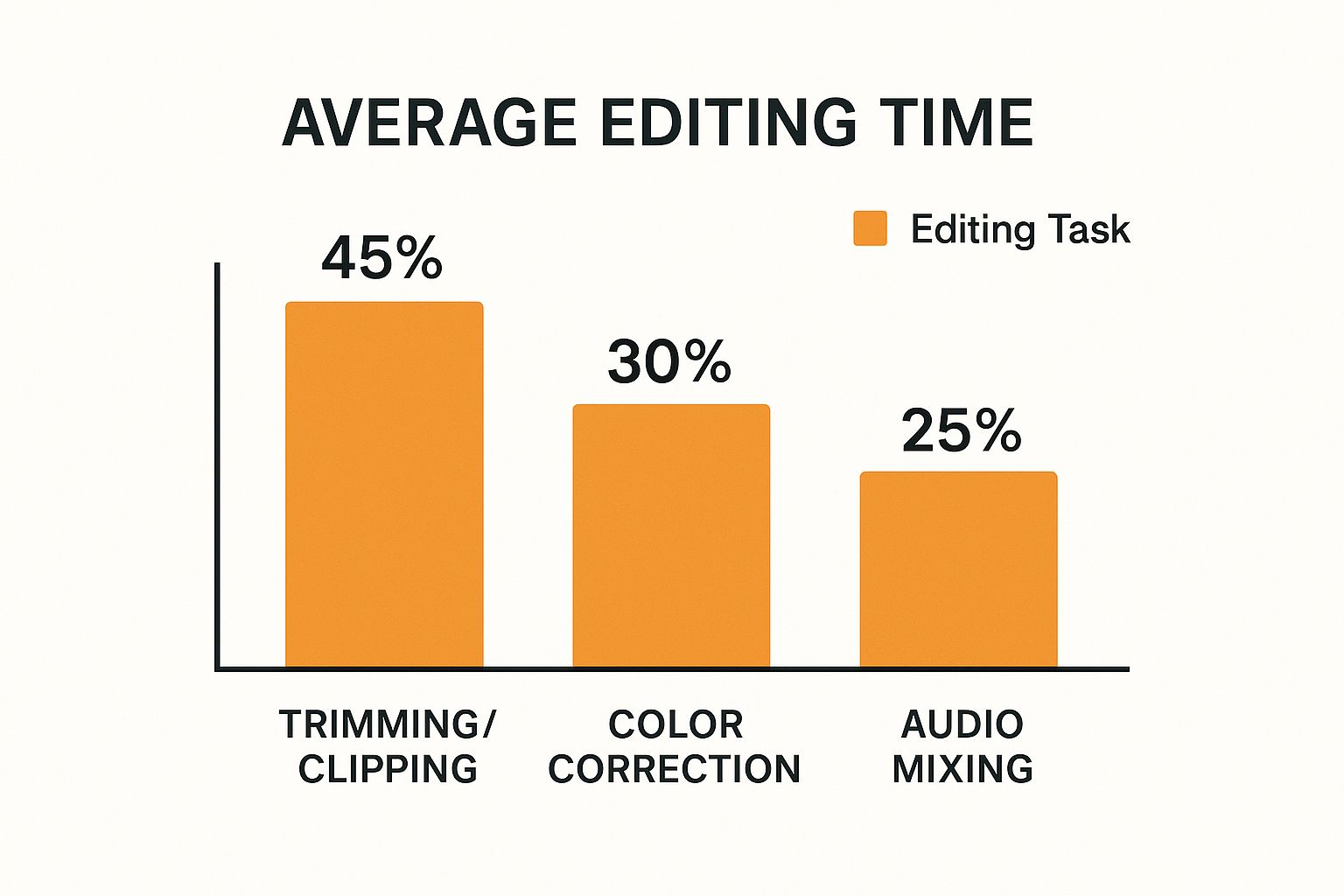


Let’s get straight to it. For builders, effective video production for social media isn't about chasing trends. It's about creating content that builds trust and helps you land better projects.
Think of it as the best tool you have for showing potential clients the quality of your work before they even pick up the phone.

These days, word-of-mouth isn't enough. Clients do their homework online, scrolling through Instagram and Facebook to see who they can trust with their biggest investment. A photo shows the finished product, but a well-made video tells the whole story.
This is where professional video gives you a serious advantage. The goal isn’t to become an influencer. It's to make your company the obvious choice for the high-value projects you want.
Put simply, video is the closest a potential client can get to an on-site visit without leaving their living room. It's your chance to make a strong first impression that static images just can't match.
A high-quality video does more than show off a finished renovation in Tauranga; it showcases your standards.
When a client sees smooth footage of your team working together, clear shots of precise joinery, and a tidy worksite, it sends a powerful message. It says you’re organised, professional, and proud of your craft.
This visual proof builds instant credibility. It answers a client’s biggest questions about your quality and process before they even ask. It’s how you set your business apart from competitors relying on a few blurry phone photos.
A great video doesn’t just show what you built; it shows how you build. It communicates professionalism, attention to detail, and a commitment to quality that builds immediate client confidence.
Your ideal clients are already on social media, looking for inspiration and vetting builders. In New Zealand, that audience is massive.
Platforms like Instagram are goldmines. As of early 2024, there are about 2.50 million users in NZ. That’s nearly half the population. With over 58% of adults on the platform, you have a direct line to homeowners planning their next build. Knowing these numbers is the first step in a smart video strategy.
Every video you post is a magnet for the right kind of work. It’s your digital portfolio, working for you 24/7. When a prospect watches a behind-the-scenes clip of a challenging coastal build you nailed, they’re not just seeing a house—they’re seeing proof of your expertise.
This consistent, professional presence doesn't just get you 'likes'. It gets you calls from serious clients who already trust your ability to deliver. To dig deeper, it’s worth exploring proven strategies for social media video marketing that actually works.
Ultimately, a solid video presence makes your sales process much easier. Clients show up already convinced of your quality. To get started right, check out our guide on the fundamentals of video production.
Great video work doesn't just happen. It’s the result of a solid plan, mapped out before anyone hits record.
Filming without a purpose is like framing a wall without plans. You’ll end up with something, but it won't be straight or do the job you need it to.
Your video blueprint is your guide. It ensures every video has a specific job, whether that's bringing in enquiries, showing off your build quality, or building trust in your brand. A simple, repeatable plan turns social media from a chore into a tool that consistently wins you work.
The point is to move from random updates to a structured approach. This makes your company look organised, professional, and the right choice for a potential client.
Before you brainstorm video ideas, you have to nail your core message. What’s the one thing you want clients to remember about your company? This isn't a slogan; it's the foundation of every video you create.
Is it the precision of your finishing work? Your transparent, no-surprises process? Or your team's expertise on complex architectural builds?
Pick one primary message to anchor your content. This focus gives your videos a consistent theme that connects with your ideal client, making it clear why they should choose you. Everything you film should circle back to this idea.
"Content calendar" might sound corporate, but for a building company, it can be simple. It’s not about posting every day. It’s about posting high-quality, purposeful content, consistently. Quality always beats quantity.
A simple calendar helps you plan ahead, making filming more efficient and less of a last-minute panic.
Here’s a practical way to approach it:
A content plan isn't a restriction; it's a tool for efficiency. It ensures that even when you’re flat-out on site, your marketing is still working in the background, building your brand and attracting the right leads.
Your videos don't need to be Hollywood productions. They just need to be authentic and offer real value. The goal is to focus on content that showcases your skill and builds trust—these are the videos that win new projects.
For a deeper dive, check out our complete guide on builder content creation for more ideas.
Here are a few proven concepts to get you started:
This blueprint gives you a clear, repeatable process. With a plan, every video will have a purpose, speaking directly to the clients you want and cementing your reputation as a top-tier builder.

You don’t need a film crew and a truck full of gear to make videos that work. But you do need the right tools for the job. A simple, reliable kit means you can capture high-quality footage on a busy site without causing delays.
This isn’t about buying the most expensive camera. It’s about being smart with a few key pieces of equipment to produce video that reflects the quality of your work. We’re focusing on what works in the real world, on a real site.
The right gear is the difference between a shaky clip and a polished video that builds instant trust.
Your smartphone is a powerful tool. Modern phones from Apple and Samsung have incredible cameras capable of producing fantastic social media content. The secret is backing them up with the right accessories to nail stability and clear sound.
Here’s a no-fluff list of gear that delivers the most value:
Good video isn't about the fanciest camera; it's about stability and clean audio. A simple tripod and an external mic will elevate your smartphone footage from average to professional, making your work look as good online as it does in person.
Capturing great footage on a live worksite is all about technique. It’s a mix of planning, an eye for detail, and a focus on safety and efficiency. This is where your social video production comes to life.
Before you hit record, take five minutes to walk the site. Look for the best angles. See where the natural light is falling. Identify background noise that could ruin your audio. A little prep goes a long way.
Here are a few practical tips for your next project.
Good lighting is everything. Avoid shooting with the sun directly behind your subject—you’ll get a dark silhouette. Instead, position yourself so the sun is lighting their face or the feature you're filming.
The "golden hour"—the soft light in the early morning or late afternoon—is your best friend. It’s more flattering and makes materials like timber and stone look rich and textured. If you're indoors, use window light to your advantage.
Even with a good external mic, a noisy site is a challenge. Film interviews or pieces-to-camera during quieter moments, like smoko or at the end of the day. If you have to film with background noise, get the microphone as close to the speaker's mouth as possible to prioritise their voice.
Think about how you’re framing your shots. Don't just stand in the middle of a room and hit record. A few simple techniques will make your videos more dynamic and professional.
You’ve got the footage. Now it's time to turn those raw clips into a story that sells your skill. Editing is what separates an average phone video from a professional piece that reflects the quality of your brand.
Don't be intimidated by complicated software. The goal isn't Hollywood special effects. It's about a clean, simple workflow that produces a credible video ready for social media.
A well-edited video builds trust just as effectively as a perfectly finished job. You’re simply assembling clips, adding a few smart touches, and making sure the final product looks like it came from a top-tier building company.
Your editing software should fit your workflow, not complicate it. There’s no need to spend money on complex programs when simpler tools can get the job done just as well. Some of the best options are probably on your phone already.
It’s like choosing between a hand saw and a drop saw—pick the one that’s right for the task.
For builders on the go, these apps are fantastic starting points:
If you’d rather work on a desktop, DaVinci Resolve has a free version with professional-grade tools that can grow with you. The main thing is to pick one tool and get comfortable with it.
A consistent process is your best friend in editing. It saves time and ensures every video has the same professional look. Once you get the hang of it, you can edit a short social media video during smoko.
The bulk of your time will be spent on the fundamentals—clean cuts and the right colour. This infographic shows where your editing time typically goes.

As you can see, most of the work is in the assembly, not adding flashy effects. Mastering these core tasks is the key to producing great videos efficiently.
Here’s your basic workflow:
Your goal in editing is clarity, not complexity. A well-paced video with clean cuts, good audio, and accurate colour will always outperform a video loaded with distracting effects. It lets your craftsmanship be the star of the show.
Once your video is pieced together, a few final details will take it from good to great. These small steps make your content look polished and reinforce your brand.
Simple colour correction is one of the most powerful adjustments you can make. You don't need to be a professional colourist. Most editing apps have simple sliders to adjust brightness, contrast, and saturation. A small tweak can make timber look warmer, whites look cleaner, and the whole project feel more true-to-life.
Finally, add your company logo. Place it subtly in a corner for the whole video, or just have it appear at the start and end. The key is to make it visible but not distracting. This ensures that even if your video gets shared, viewers will know who did the great work.

You can have the most polished video in the world, but it's useless if the right people don't see it. This is the final step where your filming and editing efforts turn into leads for your business.
Dropping a video online isn't as simple as hitting 'upload'. Every platform has its own rules, and getting these details right makes your craftsmanship look professional. It’s what makes it easy for a potential client to see the quality you deliver.
This final push is how you turn a great video into a tool that actively wins you work.
Think of social media platforms like different tools in your toolbox. You wouldn’t use a sledgehammer for finishing work. It’s the same with video. To get the best results, format your video to fit the platform.
Getting this wrong leads to awkward cropping or blurry playback, making your work look amateurish. A video formatted for an Instagram Reel will look out of place on YouTube. Taking a moment to get the specs right makes a huge difference in how clients perceive your brand.
Here's a quick reference guide to get your videos looking sharp.
Getting the technical details right ensures your work is seen as intended. This table breaks down the essentials for the platforms that matter most to builders.
Paying attention to these simple guidelines is an easy win for making your brand look professional online.
The caption gives your video context and starts a conversation. You don't need to write an essay. A couple of clear sentences explaining what people are seeing is all it takes to turn a viewer into an engaged lead.
Keep the language direct. Ask a question to get people commenting—"What do you think of this custom joinery?" or "What’s your favourite feature in this kitchen reno?" This engagement tells the platform's algorithm your content is interesting, so it gets shown to more people.
And don't forget a clear call to action. Tell people what to do next, whether that's visiting your website or getting in touch for a quote.
Hashtags are a filing system for social media. Using the right ones helps people looking for a builder in your area find your work. Think of them as signposts directing motivated clients to your door.
Don't just use generic tags like #construction. Get specific to attract a local audience.
A smart mix of these tags ensures your videos are seen by people who are in the market for your services.
Consistency builds an audience that trusts you. A regular posting schedule shows you’re a professional, active business, keeping your brand top-of-mind for when a potential client is ready to start their project.
Finally, be consistent. This doesn't mean you need to post every day. Just create a simple schedule—say, every Tuesday and Thursday—to build momentum. It shows algorithms and followers that you're a reliable, active business.
For a New Zealand audience, you’ll find the most engagement during morning commutes (7-9 am), lunch breaks (12-2 pm), and in the evenings (7-9 pm). Test a few different times and see what works best.
This consistent effort drives real growth. Video marketing is exploding. Projections show that social media video ad spending in New Zealand could hit $459.46 million by 2025. That's because 89% of businesses in our region now see video as an essential marketing tool. A steady stream of quality content builds a following that becomes your best source of qualified leads.
Jumping into video production for social media can feel like a big task. We get it. You're busy running a business and managing jobs on site. The good news? Creating videos that work is more achievable than you might think.
We hear the same questions from builders all the time. Here are some straight-up, practical answers you can use. The point is to give you the confidence to start using video to show off your craftsmanship and win better work.
This is the big one. The honest answer: it can take as much time as you give it, but a smart approach gets brilliant results without eating up your week.
You don't need to spend hours on this every day. The trick is to plan ahead and batch-film content. When you have a camera operator on site for a project milestone, get them to capture enough footage for three or four short videos at once. A single two-hour shoot could easily give you a month's worth of content.
Editing is surprisingly quick once you nail a simple workflow. A basic social video, like a site progress clip, can be edited and ready to post in under 30 minutes using an app on your phone.
You don't need to become a full-time content creator. By focusing on efficiency—planning shoots and using simple tools—a few hours of focused effort can generate a month of high-quality video. It’s an investment that pays for itself in professional credibility and better leads.
No. Not if you don't want to be. While showing your face can help build a personal connection, it's not the only way to make a great video. Your work can, and should, be the hero.
Here are a few powerful video ideas that don't require you to step into the limelight:
If you only have time to make one type of video, make it a client testimonial. Nothing builds trust faster than a happy customer sharing their experience on camera.
A testimonial video is pure social proof. It reassures potential clients that you're reliable, professional, and deliver on your promises. It tackles their biggest fears and gives them the confidence to pick up the phone.
Ask a recent client you have a great relationship with. Keep it informal and don't script it. A simple, honest chat about their experience with your team is all it takes to create a piece of marketing gold that will win you work for years.
Ready to get serious about your brand? At Onsite Media, we help New Zealand's best builders create the high-end photo and video content they need to win high-value projects. Get in touch with us today to see how we can help you show up online as good as you do on site.

